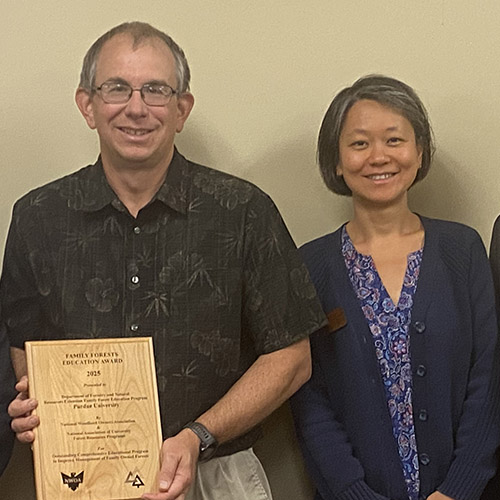Graduate Students Honor Dr. John Moser with Plaque
 What do you do to recognize someone who has impacted your life in profound ways? For a group of former graduate students who worked under Dr. John Moser in Purdue Forestry and Natural Resources, the answer was to create a plaque honoring their mentor to make sure his name and impact would be known to all of the generations to come.
What do you do to recognize someone who has impacted your life in profound ways? For a group of former graduate students who worked under Dr. John Moser in Purdue Forestry and Natural Resources, the answer was to create a plaque honoring their mentor to make sure his name and impact would be known to all of the generations to come.
The bronze plaque, which will make its home on the wall in Leopold's Landing on the second floor of Pfendler Hall, reads
"John was a mentor to hundreds of students throughout his teaching career at Purdue. His no- nonsense style was legendary, but those who knew him learned quickly that he was incredibly warm, caring and fun-loving. His hallmark was instilling a professionalism that would launch his students into highly successful careers."
The plaque was the brain child of alumnus William "Brad" Smith, who received his bachelor's degree in forestry in 1975 and master’s degree in 1977, before a 40-year career with the USDA Forest Service, which led him to receiving the Purdue Ag Alumni Association Certificate of Distinction in 2020.
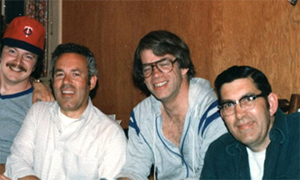
"Long story short, John Moser changed the trajectory of my life,” Smith said. "He is not only a mentor but a good friend. After I received the Certificate of Distinction last year, it occurred to me that mine was likely not the only life John touched in a significant way, so I got a list of his grad students and decided to pay homage to one of Purdue Forestry’s great mentors. We allowed much of our success to John.”
Smith and fellow Certificate of Distinction winner Steve Shifley (BS 1976, MS 1978) contacted all of the grad students they could find who had studied under Moser as they knew many likely shared their experience. Thirteen of the 16 living graduate students who benefitted from Moser's more than 40-year career with Purdue FNR were located and each shared his/her appreciation of Dr. Moser in letters. Those letters were merged into a book, which was presented to Moser and his wife, Joyce.
Moser’s students have impacted forestry across the country, from Alaska (Rachel Morse, MS 1999) to Alabama (Harold Bruner; BS 1970, MS 1972) and world, from Canada (John A Kershaw Jr., MS 1986) to Europe (Brad Smith) to South America (David Titzer, MS 1977).
KaDonna Randolph (MS 2000), the most recent of the Moser alumni group, is a research mathematical statistician for the U.S. Forest Service at the Southern Research Station in Knoxville, Tennessee. She has vivid memories of her time with Dr. Moser and credits him for guiding her career path.
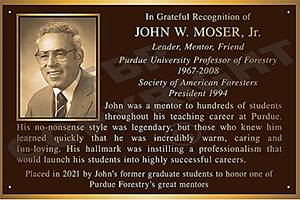 "I was privileged to have Dr. Moser as my major advisor beginning in January 1998,” Randolph stated. "I helped with his undergraduate forestry classes and enjoyed the conversations we had during the measurements labs at McCormick Woods. Topics of conversation ranged from forestry and football to those lazy wildlife students who couldn't understand why they would ever need to measure trees. He’d laugh and ask, “where do they think the wildlife live?"
"I was privileged to have Dr. Moser as my major advisor beginning in January 1998,” Randolph stated. "I helped with his undergraduate forestry classes and enjoyed the conversations we had during the measurements labs at McCormick Woods. Topics of conversation ranged from forestry and football to those lazy wildlife students who couldn't understand why they would ever need to measure trees. He’d laugh and ask, “where do they think the wildlife live?"
"I graduated in May 2000 and after about a year found myself entering a PhD program funded by the Forest Service Forest Inventory & Analysis Program. Dr. Moser offered counsel about that decision and having him as a reference undoubtedly boosted my application. He was right when he said Forest Inventory and Analysis (FIA), not Forest Health Monitoring (FHM), was the place to be. For that, and so much more, I will always be ever grateful, ever true."
Shifley recalls seeing two distinct sides of Dr. Moser, first as an undergraduate in Forest Management (FORS 408) and then as a master’s student in Forest Dynamics.
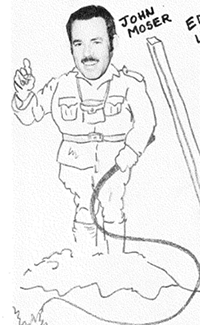 "Forestry 408 was anything but easy, and every year some would-be foresters failed the class and had to come back a year later for another try," Shifley, who retired after 40 years as a research forester for the U.S. Forest Service Northern Research Station, shared. "Subsequent tries were labeled Forestry 816, Forestry 1224, Forestry 1632, etc. It was a highly quantitative course with endless hand calculations as well as applications of computer programs. Dr. Moser was relentless as the instructor. Full credit on assignments required professional-looking reports and copious methodological details far beyond any class I had previously encountered. It was the hardest and the most fulfilling class I had in my undergrad program, and for me it set off what evolved into a career in quantitative forestry."
"Forestry 408 was anything but easy, and every year some would-be foresters failed the class and had to come back a year later for another try," Shifley, who retired after 40 years as a research forester for the U.S. Forest Service Northern Research Station, shared. "Subsequent tries were labeled Forestry 816, Forestry 1224, Forestry 1632, etc. It was a highly quantitative course with endless hand calculations as well as applications of computer programs. Dr. Moser was relentless as the instructor. Full credit on assignments required professional-looking reports and copious methodological details far beyond any class I had previously encountered. It was the hardest and the most fulfilling class I had in my undergrad program, and for me it set off what evolved into a career in quantitative forestry."
"That autumn I had Dr. Moser for a graduate Forest Dynamics class, and that is when I met the real John Moser. In that class I learned John was warm, funny, supportive, and kind. We learned that his gruff demeanor in Forestry 408 was a well-rehearsed act designed to challenge senior forestry students to become disciplined and professional as they embarked on their careers. Graduate school with John was a totally different experience from the undergraduate program. He coached us with honest assessments of our work. He provided guidance and encouragement. And he taught by example. He also taught us that it is important at the end of the day to have some fun, and John was expert at that, as well."
Moser’s high demands on his students proved beneficial in their careers beyond Purdue.
"John inspired all of us with his "listening", very focused guidance, sometimes spiced with his razor- sharp humor, and most importantly with his insistence on excellence, as he did everyday with his own example," said David Titzer (MS 1977), who is a consultant for Forest and Wood Products, South America. "All of us strove to not disappoint him. Throughout my forestry career, and life, John's mentoring and self-excellence standards have been an important foundation for me as I have also sought to lead and mentor."
Moser’s impact on and connection with his students extended well past their time in West Lafayette.
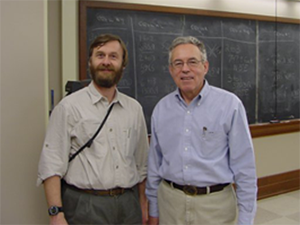 "The rapport I have with my students was learned from time spent with John Moser, Tom Beers, W.L. Mills (also on my Masters’ committee and a PhD student of John’s) and Burney Fischer (my Master’s supervisor)," said John A. Kershaw, Jr., assistant vice president of partnerships at the University of New Brunswick. "The last talk I saw John give was at the Northeast Mensurationists meeting in Boothbay Harbor, Maine, in 2000. John talked about the significance of "People," "Places," and "Processes". I have probably heard 1000 talks since then, I cannot think of a single talk that impacted me more than that talk John gave. Many people have touched my life, and John was right, it is the people, the places, and the processes. The lessons I carry with me from time spent with John have served me well and opened doors around the world."
"The rapport I have with my students was learned from time spent with John Moser, Tom Beers, W.L. Mills (also on my Masters’ committee and a PhD student of John’s) and Burney Fischer (my Master’s supervisor)," said John A. Kershaw, Jr., assistant vice president of partnerships at the University of New Brunswick. "The last talk I saw John give was at the Northeast Mensurationists meeting in Boothbay Harbor, Maine, in 2000. John talked about the significance of "People," "Places," and "Processes". I have probably heard 1000 talks since then, I cannot think of a single talk that impacted me more than that talk John gave. Many people have touched my life, and John was right, it is the people, the places, and the processes. The lessons I carry with me from time spent with John have served me well and opened doors around the world."
Eric Rauch (MS 1976) thanked Moser for his own 30-year career working with the Tennessee Valley Authority.
"From both professional and personal standpoints, I owe John for helping me land my second position after leaving Purdue," said Rauch, who retired as manager of stewardship projects in the TVA Office of Natural Resources. "I was working for a pulp and paper company in southwest Alabama when I received a call out of the blue from the person who would ultimately be my next supervisor. John had met him at a SAF meeting and during their discussion John learned that the TVA Department of Forestry, Fisheries and Wildlife Development was looking for someone who just happened to have exactly the skill set that I had acquired under John’s tutelage. John shared my contact information, hence the call. That led to a move to east Tennessee and a 30-year career working in natural resources with TVA. My wife and I raised our two kids here and have no reason to ever leave this part of God’s Country. That wouldn’t have happened if not for John."
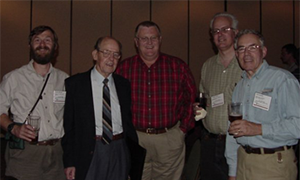 Moser, who retired in 2008, is actually a Purdue FNR alumnus himself, completing his Ph.D. in 1967 and acting as a graduate instructor, eventually moving up to assistant department head before retiring in 2008 as a Professor Emeritus.
Moser, who retired in 2008, is actually a Purdue FNR alumnus himself, completing his Ph.D. in 1967 and acting as a graduate instructor, eventually moving up to assistant department head before retiring in 2008 as a Professor Emeritus.
Moser also served as president of the Society of American Foresters in 1994 among many other chapter and national-level positions. He was elected as an SAF Fellow in 1987, received the Tree of Life Award from the Canadian Institute of Forestry in recognition of notable contributions to sustainable forest management in 1994, and earned the John A. Beale Memorial Award for exemplary service to SAF in 1997. In 2003, he garnered the director’s award for FIA Excellence from the USDA Forest Service and also earned the USDA Forest Service Chief’s Certificate of Appreciation. In 2004, Moser received the Meritorious Service Award from the Indiana Society of American Foresters.
Moser’s legacy at Purdue reaches far beyond his influence in the classroom.
"What I remember most about Dr. Moser is how skillfully he navigated department and university politics," said Rachel Morse (MS 1999), a consultant with The Foraker Group in Anchorage, Alaska. "He was clearly very influential, but he stayed out of the fray. He built his reputation on quality solid research, good ideas, tangible results, and professionalism and he made genuine connections with colleagues across the country who became friends. He was more concerned about making the right things happen than who was the department head or who got credit. However, he wasn’t a pushover. He was always self-assured and confident, and the best-dressed professor on campus. He had this thin smile I saw him give others and they would back down because the reputation he had built was solid, his influence wide and his aim true. You had to be smart to be his graduate student, as well as hardworking and willing to choose the challenging path. You had to take the toughest statistic classes and set up the best research. But if you made it through, he looked after you, got you connected and continued to forward your career."
Those qualities will be on display for all who see the plaque in Pfendler Hall for generations to come.






